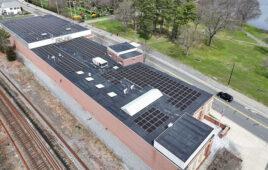A new solar generating plant—Stanford’s second—will enable the university to use 100% renewable electricity in three years, more than two decades ahead of California’s goal of a carbon-free grid by 2045.
Completing the university’s transition to clean power, Stanford finalized an agreement to collaborate with Recurrent Energy on an 88-MW solar PV plant to be constructed in central California, near Lemoore. The plant is scheduled to go online in late 2021.

Solar panels on the Central Energy Facility looking toward Hoover Tower on campus at Stanford University. (Photo Credit: M. Scott Gould)
Stanford’s current greenhouse gas emissions already are down by 66% from peak levels due to advances from the Stanford Energy System Innovations(SESI). The new solar plant, to be known as Stanford Solar Generating Station #2, is projected to reduce GHG emissions even further, to 80% below peak levels—four years ahead of the renewable energy goal established in the university’s long-range planning process.
Canadian Solar announced its wholly owned subsidiary Recurrent Energy signed a 25-year power purchase agreement for the 63-MWac/88-MW Stanford Solar Generating Station #2.
“This power purchase agreement with Stanford University demonstrates Recurrent Energy’s ability to work with a diversified customer base in California and across the U.S. We’ve long partnered with different types of load-serving entities, such as investor-owned and publicly-owned utilities, and we’re a known leader for our partnerships with CCAs. Now, we are delighted to also demonstrate our ability to meet the needs of direct access customers,” said Dr. Shawn Qu, chairman and CEO of Canadian Solar. “We feel honored to help Stanford University achieve its goal to source 100% of its campus’ electricity from renewable energy.”
The new station will augment the 67-MW Stanford Solar Generating Station #1 in Rosamond, California, which came online in 2016, and 5 MW of on-campus rooftop solar power, which came online in 2017. The three installations will produce enough clean renewable electricity each year to equal the university’s annual electricity consumption.
The Stanford Solar Generating Station #2, located on over 400 acres in Kings County, California, will power the equivalent of 15,750 homes with clean electricity. This PV project, together with Stanford University’s existing 67-MW solar PPA and its 5-MW rooftop installation, will produce enough clean renewable electricity each year to equal the university’s annual electricity consumption.
“As a university, we are pursuing an ambitious plan to further reduce our carbon footprint, and our second solar plant is a critical new component of that plan,” said Stanford President Marc Tessier-Lavigne. “Sustainability is a major focus for Stanford and a priority for our local community. Completing our transition to clean power builds on the groundbreaking research of Stanford faculty and students, and it marks a major advance in our efforts to provide a sustainable learning environment for our campus.”
As part of Recurrent Energy’s Slate project portfolio, the Stanford Solar Generating Station #2 is scheduled to enter operation in 2021. Canadian Solar announced last month that another 150 MWac portion of the Slate portfolio has PPAs executed with Silicon Valley Clean Energy and Monterey Bay Community Power.
Stanford achieved a 50% reduction in its greenhouse gas emissions in 2015, when the SESI electricity-powered heating and cooling plant replaced an aging, gas-fired cogeneration plant that had served the university since 1987.
“After we built the new plant, we were able, through California’s regulatory process, to secure control over all electricity purchases and source the kind of electricity we wanted,” said Joseph Stagner, Stanford’s executive director of sustainability and energy management. “The university leadership promptly said: Let’s go out and make that clean power and help reduce our dependence on fossil fuels for campus operations.”
When Stanford’s first solar plant went online in 2016, the university increased its clean electricity portfolio to 65%, up from the state minimum of 27%, and has since further reduced university greenhouse gas emissions to 66% below peak levels.
News item from Recurrent Energy & Stanford University





Tell Us What You Think!